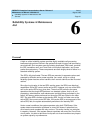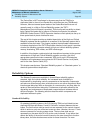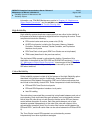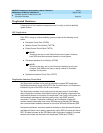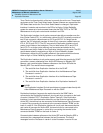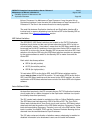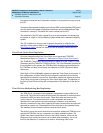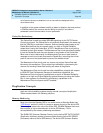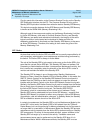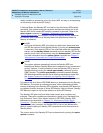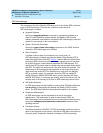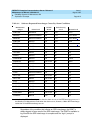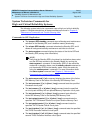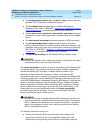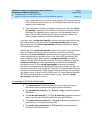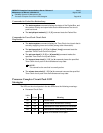
DEFINITY Enterprise Communications Server Release 6
Maintenance for R6vs/si
555-230-127
Issue 1
August 1997
Reliability Systems: A Maintenance Aid
Page 6-9Duplication Concepts
6
Circuitry sends this information to the Common Shadow Circuitry on the Standby
SPE Duplication Interface via the ICC. The Common Shadow Circuitry on the
Standby SPE Duplication Interface then writes the data to Standby SPE Memory.
This logical connection between Active SPE Memory and Standby SPE Memory
is known as the SHDW-LNK (Memory Shadowing Link).
Although most of the components making up the Memory Shadowing Link (that
is, Active SPE Memory, both sets of Common Shadow Circuitry, and Standby
SPE Memory) are tested and maintained individually, the integrity of the entire
logical connection is also tested and maintained to make sure that the
shadowing mechanism is functional and that Standby SPE Memory is the same
as Active SPE Memory. Therefore, this testing is done under the guise of the
Memory Shadowing Link.
SPE Modes
As described earlier, the Active SPE is the SPE that is currently responsible for all
call processing, administration, and maintenance activities being performed by
the switch. The Active SPE is always in Active Mode.
The role of the Standby SPE is to be ready to take over as the Active SPE in the
event that the current Active SPE fails. The Standby SPE does not perform Call
Processing or Administration activities. It does perform Maintenance activity, but
this is carried out completely under the direction of the Active SPE in order to
monitor and maintain the health of the Standby SPE.
The Standby SPE is always in one of three modes: Standby, Maintenance,
Busyout, or Down. Usually the Standby SPE is in Standby Mode. In this mode, the
SW-CTL (Switch Control) on the Standby SPE Network Control circuit pack is
isolated from the TDM Bus so that it does not attempt to control the bus and
interfere with the Switch Control on the Active SPE Network Control circuit pack.
Similarly, the Standby SPE Packet Control circuit pack is isolated from the Packet
Bus so that it does not attempt to control the Packet bus, and thus interfere with
the Active SPE Packet Control circuit pack. The Standby SPE PROCR
(Processor) is held in a reset state so that it does not run software. Finally,
Standby SPE is being shadowed into from Active SPE Memory
—meaning that
Standby SPE Memory is updated to reflect every change in Active SPE Memory
(for example, calls and administration changes). In Standby Mode, the Standby
SPE is available to assume the role of the Active SPE.
In certain circumstances, the Standby SPE is put into Maintenance Mode by the
Active SPE. In this mode, the Standby SPE is still isolated from the TDM and
Packet Buses, but is no longer having its Memory shadowed into; its Processor is
no longer held in a reset state. In Maintenance Mode, the Standby SPE accepts
maintenance activity requests from the Active SPE to perform testing on Standby
SPE components. For many of the requested activities, system software on the
Standby SPE is brought up to conduct the activity. Translation saves and
announcement saves may be performed on the Standby SPE when it is in
Maintenance Mode. While in Maintenance Mode, the Standby SPE is not as



